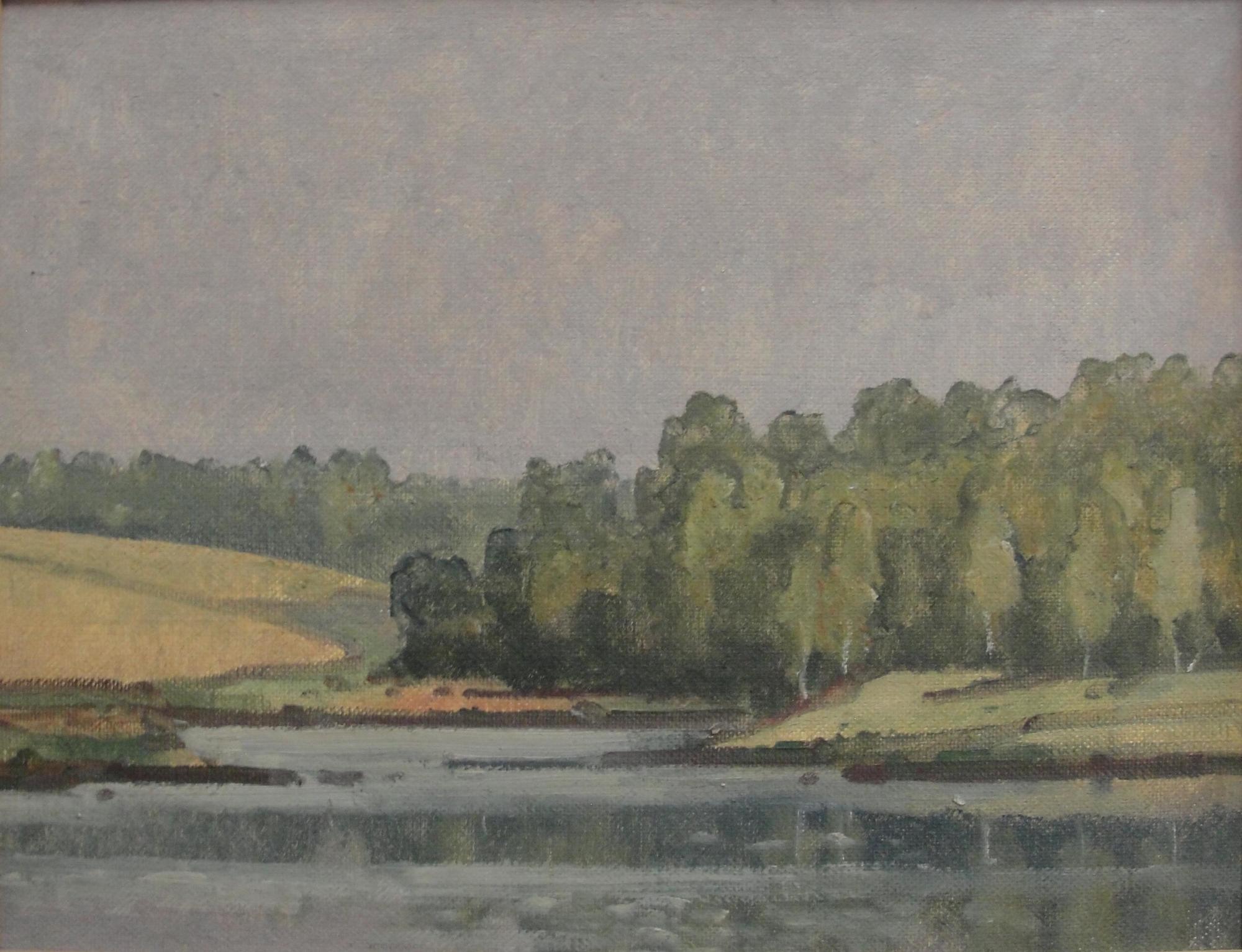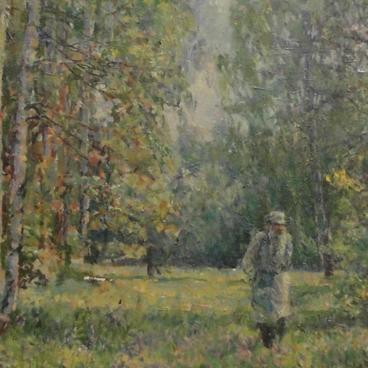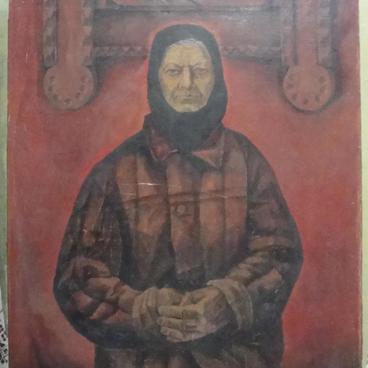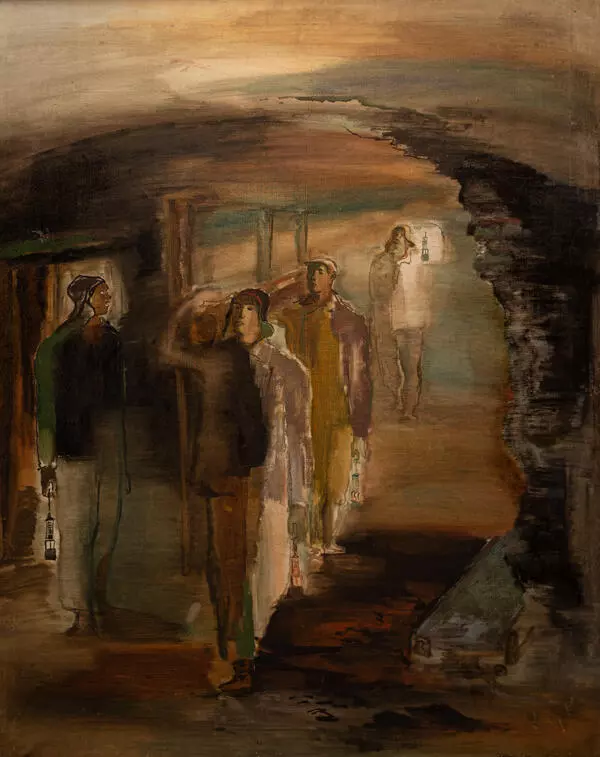Soviet monumental painter Ivan V. Ivanovsky is considered to be a master of portrait painting. He created a cycle of paintings under the name of ‘Chiatura Miners’, painted portraits of best workers and agricultural laborers, his relatives and friends. In addition, he was often engaged to design pavilions, halls, lobbies, created massive thematic panels. However, the artist himself confessed that his heart only filled with joy when he worked on landscapes, as there was nothing more beautiful and perfect than the nature.
Landscape The Pond in Rozhdestveno was painted during one of such periods of happiness. The subdued colors and yellow fields at a distance suggest that Ivanovsky went to this village near Moscow in the early autumn. The day was cloudy, and the artist, with amazing precision, conveyed all shades of the grey troubled sky, graphite water, and the forest — as if frozen in anticipation of a cold autumn rain. In the 19th and 20th centuries, Rozhdestveno was a place of relaxation popular among writers and artists, where Anton P. Chekhov was a frequent visitor. However, there are no people on Ivanovsky’s painting, the author as if wanted to emphasize the silent and reserved beauty of the nature.
Ivan V. Ivanovsky was born in 1905. Having received the initial education in the gymnasium of the city of Alexandrov in the Vladimir Province, he decided to dedicated himself to art and moved to Moscow. He mastered the basics of his future profession in the Higher Studios of Art and Technology (VHUTEMAS) where he studied until 1930. Still in his student years, he joined the Easel Painters’ Society which promoted the ideas of socialism in art. However, Ivan Ivanovsky’s diploma work “Laundresses”, too grotesque and devoid of any artistic gloss, gave rise to critical comments which were far from flattering.
After the split of the Easel Painters’ Society, Ivanovsky acceded to artistic association ‘Izobrigada’ where he felt uncomfortable because its participants considered classical painting as a bourgeois anachronism. Together with his associates, he established creative group ‘TIGI’, but, as the result, was accused of formalism. Ivanovsky’s opponents asserted that his monumental panels were just a method to make a living, and, in his free time, the artist painted “petty-bourgeois” landscapes which the Soviet society did not need.
Anyway, for whatever reason, in his lifetime, Ivanovsky had only one personal exhibition in 1976. But before the war, the artist’s works were successfully exhibited in the USA, France, Austria, Germany, Great Britain. The last major exhibition was posthumous and took place in 1985. The organizers timed it to coincide with the artist’s anniversary.
Landscape The Pond in Rozhdestveno was painted during one of such periods of happiness. The subdued colors and yellow fields at a distance suggest that Ivanovsky went to this village near Moscow in the early autumn. The day was cloudy, and the artist, with amazing precision, conveyed all shades of the grey troubled sky, graphite water, and the forest — as if frozen in anticipation of a cold autumn rain. In the 19th and 20th centuries, Rozhdestveno was a place of relaxation popular among writers and artists, where Anton P. Chekhov was a frequent visitor. However, there are no people on Ivanovsky’s painting, the author as if wanted to emphasize the silent and reserved beauty of the nature.
Ivan V. Ivanovsky was born in 1905. Having received the initial education in the gymnasium of the city of Alexandrov in the Vladimir Province, he decided to dedicated himself to art and moved to Moscow. He mastered the basics of his future profession in the Higher Studios of Art and Technology (VHUTEMAS) where he studied until 1930. Still in his student years, he joined the Easel Painters’ Society which promoted the ideas of socialism in art. However, Ivan Ivanovsky’s diploma work “Laundresses”, too grotesque and devoid of any artistic gloss, gave rise to critical comments which were far from flattering.
After the split of the Easel Painters’ Society, Ivanovsky acceded to artistic association ‘Izobrigada’ where he felt uncomfortable because its participants considered classical painting as a bourgeois anachronism. Together with his associates, he established creative group ‘TIGI’, but, as the result, was accused of formalism. Ivanovsky’s opponents asserted that his monumental panels were just a method to make a living, and, in his free time, the artist painted “petty-bourgeois” landscapes which the Soviet society did not need.
Anyway, for whatever reason, in his lifetime, Ivanovsky had only one personal exhibition in 1976. But before the war, the artist’s works were successfully exhibited in the USA, France, Austria, Germany, Great Britain. The last major exhibition was posthumous and took place in 1985. The organizers timed it to coincide with the artist’s anniversary.




